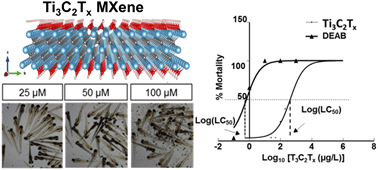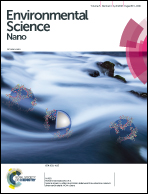Ecotoxicological assessment of Ti3C2Tx (MXene) using a zebrafish embryo model
Abstract
The recent application of 2D Ti3C2Tx (MXene) nanomaterials as adsorbents and membranes for water treatment as well as for biomedical applications is attracting a growing interest. However, the environmental impact of MXene nanomaterials, especially their potential risks on aquatic biota and ecosystems of the aquatic environment, has never been explored. Herein, we have studied the biocompatibility of Ti3C2Tx by analyzing its potential toxicity in vivo using a zebrafish embryo model. Ti3C2Tx morphology, surface charge, and stability were characterized by SEM, TEM, and X-ray diffraction spectroscopy. The aggregation patterns of Ti3C2Tx suspensions in seawater were investigated. The ICP-MS results showed that the zebrafish embryos can uptake Ti3C2Tx in a dose dependent manner. The acute toxicity of attached/absorbed Ti3C2Tx was tested at concentrations of 25, 50, 100 and 200 μg mL−1. According to the 96-hour sigmoidal mortality curve, the LC50 of Ti3C2Tx was calculated to be 257.46 μg mL−1 and the highest NOEC (<20% mortality) was 50 μg mL−1. The LOEC (≥20% mortality) of Ti3C2Tx was detected to be 100 μg mL−1, as this concentration showed a slight increase in mortality (21%). However, no significant teratogenic effects were observed on zebrafish embryos at 100 μg mL−1. This nontoxicity was confirmed by locomotion and neurotoxicity assays, as 50 μg mL−1 of Ti3C2Tx showed no harmful effects on neuromuscular activities. In conclusion, because the LC50 of Ti3C2Tx was greater than 100 μg mL−1, it can be classified as within the “practically nontoxic” group according to the Acute Toxicity Rating Scale by the Fish and Wildlife Service (FWS); thus, we suggest the safe use and discharge of Ti3C2Tx MXene in the aquatic ecosystem at concentrations below 100 μg mL−1.

- This article is part of the themed collection: Best Papers 2018 – Environmental Science: Nano


 Please wait while we load your content...
Please wait while we load your content...